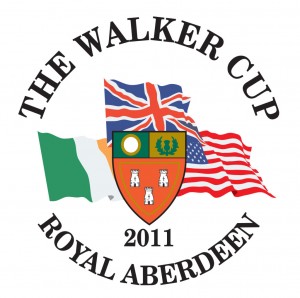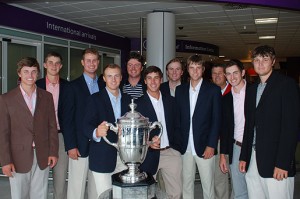Choosing a Path – Amateur or Professional?
This month, two of golf’s great contests take place in the British Isles. First, the Walker Cup tees off this Saturday at Royal Aberdeen Golf Club, and in a couple of weeks Killeen Castle will provide the spectacular backdrop for the Solheim Cup. Both will undoubtedly provide fascinating viewing, and if previous billings are anything to go by, the Walker Cup will provide us a glimpse of future stars.
Dustin Johnson, Rory McIlroy and Rickie Fowler are unquestionably the new breed of superstars on tour, yet a couple of years ago they were ‘unknowns’ competing in the Walker Cup matches themselves.  Top level amateur golf is of such a high standard these days, that arguably the only difference between the best amateurs and many of the Tour players is just the absence of a pay cheque. For the most talented, the leap from the amateur game to the professional ranks today appears to be a small one – just look at the smooth transition these aforementioned names have made to the highest echelons of the game. And what about the assured performance of Tom Lewis at The Open this year?
Top level amateur golf is of such a high standard these days, that arguably the only difference between the best amateurs and many of the Tour players is just the absence of a pay cheque. For the most talented, the leap from the amateur game to the professional ranks today appears to be a small one – just look at the smooth transition these aforementioned names have made to the highest echelons of the game. And what about the assured performance of Tom Lewis at The Open this year?
All this said, for the majority, perhaps not blessed with quite the same talent or mental fortitude, the step-up and the pressure that comes with it will prove too much and they will remain ‘unknowns’, grinding out a career as a journey-man pro or falling by the wayside.
The Walker Cup isn’t the only route into a life of competing for the riches of the pro tour, but, for the rest of us, it is a fascinating first view of the talents of the future, and perhaps our only glimpse of those who won’t quite make it – it’s a very fine line between success and failure.
All the Walker Cup players are selected on merit and the next challenge for them will be to make a living on merit, too. Easier said than done. So what’s the best route? Whether it be the amateur ranks or the professional satellite tours, there’s likely to be a long road ahead.
Walker Cup Players
For the representatives on each team, the Walker Cup is liable to be the pinnacle of their amateur career, if not their golfing career.  For these guys, the path will be mapped out for them, but they’re the elite few. Walker Cup players are handed out sponsor’s exemptions into tour events, have management companies crawling all over them, and will benefit from untold guidance and coaching. The experience these days is not far removed from those of the Ryder Cup teams in the 1980s. Doubtless, it’s an environment that breeds success, and anybody fortunate enough to have been selected should milk it for all it’s worth.
For these guys, the path will be mapped out for them, but they’re the elite few. Walker Cup players are handed out sponsor’s exemptions into tour events, have management companies crawling all over them, and will benefit from untold guidance and coaching. The experience these days is not far removed from those of the Ryder Cup teams in the 1980s. Doubtless, it’s an environment that breeds success, and anybody fortunate enough to have been selected should milk it for all it’s worth.
The Rest
But what about those guys who don’t make the Walker Cup? Inevitably at some point along the golfing career path they have to make the decision as to when to turn pro. But is this going to make life any easier to reach the top? Knowing the right answer is a tough one, and personally I tend to believe that everyone’s circumstances are unique. But there are some considerations that often get overlooked in the pursuit of playing golf for money.
Speaking from personal experience (and it’s a view I consistently heard from fellow players), amateur golfers often get frustrated over two things – the lack of opportunity to play in the biggest events e.g. the British Amateur where the cut off for maximum handicap falls at around +3; and maximum prize values of £500, awarded more often than not as merchandise. OK this is not to be sniffed at, but as the maximum you can play for as an amateur it doesn’t help pay the bills. As a consequence, the lure of playing on the developmental tours often becomes too great, and many opt for an environment where consistent performance can be rewarded with cheques in the thousands.
However, the satellite tour is a tough place to ply your trade. The stark reality is that the only place you’ll make money live is on the main tour – that is, the European Tour, if you’re from this part of the world. What’s also true for the satellite player is that there are very limited opportunities to progress on to the European Tour. In short, you have two routes that are open to amateurs and professionals alike (just increasing the competition), which are the annual Tour School, and qualifying for The Open (or French Open, etc) where you’d then have to finish in the top 10. For professionals, a top five season finish on a ‘feeder tour’ would allow you to graduate to the Challenge Tour.
 As an amateur, if you can get your handicap low enough to play in the British, European, and US Amateur Championships (amongst others), these all provide the winner with an opportunity to compete in the respective national Open Championships, and therefore further opportunities to win enough money to gain a tour card. And who wouldn’t want the chance to play in The Masters and The Open? Admittedly it’s a long shot, as there are hundreds of competitors with a lot of talent and just one winner, but regardless it remains a possibility, and one that is not open to satellite tour professionals.
As an amateur, if you can get your handicap low enough to play in the British, European, and US Amateur Championships (amongst others), these all provide the winner with an opportunity to compete in the respective national Open Championships, and therefore further opportunities to win enough money to gain a tour card. And who wouldn’t want the chance to play in The Masters and The Open? Admittedly it’s a long shot, as there are hundreds of competitors with a lot of talent and just one winner, but regardless it remains a possibility, and one that is not open to satellite tour professionals.
The great risk for the amateur is that the significant financial investment to compete in tournaments (something I’ve touched on before and could write another thesis) comes with no potential for return on that investment – the money all goes in one direction. OK, if you get selected by the national team your expenses will be paid but even then it’s still a case of no money earned, just no money spent either.
For me, this is where the line in the sand is drawn. Those on the brink of selection for their country as an amateur should reap these benefits for as long as possible in their pursuit of professional glory. After all, the aim of the national governing bodies is ultimately to develop these players into future stars and you can be assured that every opportunity will be presented to you. Make the most of it.
For those not on the cusp of selection, perhaps starting early in the lowest ranks of professional golf is the right one. It at least allows you to test your ability playing for money, which is the nature of the profession. Play well, and within a year you can be mixing it up with the top players in the world. Anything short of robotic consistency and it can become a brutal reality check, and one that a large number of golfers struggle to accept. Ultimately, if you can’t make money on the developmental tours, you’re probably unlikely to make money on the European or PGA Tours – as the PGA Tour slogan goes “these guys are good”! Of course there are exceptions to the rule – if you’ve ever read any of John Feinstein’s golf books you’ll know of many instances where players are on the cusp of packing the game in, only to find success with that last roll of the dice.
Playing developmental tours as a pro, and playing at the top level of the amateur game both provide pathways to success, and whilst the performances and future careers of the players at the upcoming Walker Cup matches will be of great interest, it’s worth bearing in mind that the choice to turn professional is arguably a lot easier for this crop of players than it is for the talented pool of aspiring golfers just behind them in the pecking order. With a number of guaranteed starts on tour and an element of ‘spoon feeding’ from management companies, life is a lot simpler.
For the rest, whether they stay amateur or turn pro, windows of opportunity are few and far between, so when a chance comes they have to grab it. It’s also easy to see why many agonise over the decision. Finances will often dictate, but if the choice is purely down to the number of potential opportunities to progress, it is difficult to argue that the professional route offers any great advantage over the amateur – even if you’re not in the Walker Cup team.